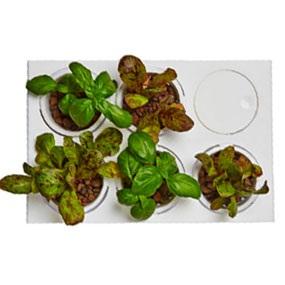Meet the new Water Garden — a self-cleaning fish tank that grows organic sprouts and herbs. In this low-maintenance, mini aquaponics ecosystem, the fish feed the plants, and the plants clean the water — no water changes required! Perfect as a hands-on family/classroom project, or a unique gift for the pet or gardening enthusiast in your life.
This beautifully redesigned 3-gallon fish tank features elegant curved edges, making it a perfect addition to any home. Now with twice the growing space, optimized water circulation, and customized Grow Pods, harvesting your own fresh herbs at home has never been more easy & fun!
The Water Garden includes everything you need to get started: 3-gallon, shatter-resistant fish tank, gravel, organic seeds, Growstones, natural d-chlorinator, a coupon for a betta fish, and natural fish food. Manufactured in the USA.
This closed-looped ecosystem is powered by aquaponics — the combination of aquaculture, or fish farming, with hydroponics, or growing plants in nutrient-rich water. Here's how the self-cleaning cycle works:1. Your fish produces nutrient-rich waste. 2. In regular aquariums, the nutrient-rich waste builds up and becomes harmful to your fish. In this Water Garden, the plants are continually taking up these nutrients as food to grow. 3. The clean filtered water drops back down to your fish.
The AquaFarm combines a 3-gallon fish tank with a vegetable and herb grow bed into one closed-loop system that fits easily on any kitchen counter. The waste from the fish provides nutrients for the plants, and the plants clean the water for the fish!
A self-cleaning fish tank that grows plants
Aquaponics is an ancient sustainable method of farming developed by the Aztecs. It uses 90% less water than traditional farming methods and combines aquaculture (raising aquatic animals) with hydroponics (cultivating plants in water). Scaled down to a table-top system, this is what happens inside the AquaFarm: 1. Fish waste, which is toxic to the fish if allowed to accumulate, is pumped through an inner tube in the tank into a grow tray above containing plants. 2. The plant roots act as a biofilter where beneficial bacteria break down the harmful ammonia in the waste into nitrites and then finally nitrates which are absorbed as food by the plants. 3. The clean water is circulated back into the fish tanks so all you have to do is feed the fish!
We include organic wheatgrass and basil seeds with every AquaFarm. If you’re looking to grow other plants, leafy greens and herbs work best. We recommend parsley, cilantro, mint, arugula, mixed greens, and other varieties of basil.
The AquaFarm is not suitable for fish that are particularly sensitive to fluctuating ammonia and nitrite levels. This is a completely biologically-filtered system, and it does take time for the tank to cycle and become balanced. For this reason, we recommend betta fish, as they are especially hardy. Zebra danios and guppies also work well with the AquaFarm at numbers of two to three per tank. If you decide to keep goldfish, please make sure you have a larger tank to move them to once they outgrow the 3 gallons!
If you have a betta, you can only keep one per tank, as they will fight if kept with other fish. If you’re keeping other more peaceful fish, the general rule of thumb is 1” of fish per gallon.
- Bettas are tropical fish, and happiest in water between 76-82 F. If your home is not regularly a temperature in this range we recommend a heater for your betta.
- Algae is a common issue in aquariums and develops as a result of the combination of excess nutrients in the water and sunlight. Being careful not to overfeed your fish is one way to prevent nutrients from building up. If your AquaFarm is in a spot that receives very direct sunlight, this is great for the plants, but not the tank water. In this situation, consider putting a back panel over the tank side to prevent sunlight from hitting the water.
- Don’t forget to feed your fish. Push the feed cap down to rotate it open and drop 5-6 pellets of the included food into the tank.

